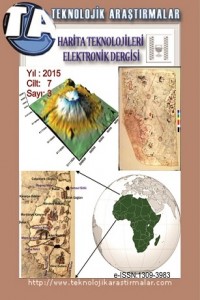Abstract
Veri işleme teknolojilerindeki gelişmelere paralel olarak harita, inşaat, maden, ziraat, mimari ve planlama gibi birçok mühendislik alanında yaygın olarak kullanılmaya başlanan Sayısal Yükseklik Modeli (SYM) nin oluşturulmasında yoğun ve doğru yükseklik verisi temini konusu önem kazanmaktadır. GPS (Global Positioning System), IMU (Inertial Measurement Unit) ve lazer tarama teknolojilerinin entegrasyonu ile oluşturulmuş üç boyutlu veri toplama yöntemi olan LiDAR (Light Detection and Ranging) sayısal yükseklik verisi üretimi konusunda klasik yöntemlere göre öne çıkmaktadır. Bu çalışmada hava LiDAR yöntemi ile temin edilen nokta bulutlarının örnekleme yoğunluğunun oluşturulan SYM lerin doğruluğu üzerindeki etkisi araştırılmıştır. Seçilen test alanında uniform metoduna göre %1, 5, 25, 50 ve 75 örnekleme yoğunluğu ile oluşturulan SYM ler hava LiDAR nokta bulutunun tamamı kullanılarak oluşturulan SYM ile karşılaştırılmıştır. Kriging enterpolasyon yönteminin kullanıldığı SYM lere ait sonuçlar örnekleme noktalarından elde edilen karesel ortalama hata değerlerine göre incelenmiştir.
References
- Yanalak, M., (2002). Sayısal Arazi Modellerinde Yükseklik Enterpolasyonu, Harita Dergisi, 128, 44-58.
- Kienzle, S., (2004). The effect of DEM raster resolution on first order, second order and compound terrain derivatives, Transactions in GIS, 8 (1), 83-111.
- Liu, X., Zhang, Z., Peterson, J . ve Chandra, S., (2007). The Effect of LiDAR Data Density on DEM Accuracy, MODSIM07 International Congress on Modelling and Simulation, Christchurch, New Zealand.
- Tunalıoğlu, N. ve Soycan, M., (2011). Geçki Planlama Çalışmaları İçin Hava Lidar Verisine Dayalı Sayısal Arazi Modelleme ve Doğruluk Analizi, TMMOB HKMO 13. Türkiye Harita Bilimsel Kurultayı, Ankara.
- Petzold, B., Reiss, P. ve Stossel, W., (1999). Laser scanning-surveying and mapping agencies are using a new technique for the derivation of digital terrain models. ISPRS Journal of Photogrammetry & Remote Sensing, 54, 95-104.
- Meng, X., Currit, N. ve Zhao, K., (2010). Ground filtering algorithms for airborne LiDAR data: A review of critical issues. Remote Sensing, 2 (3), 833-860.
- Liu, X., (2008). Airborne LiDAR for DTM generation: Some critical issues. Progress in Physical Geography, 32 (1), 31-49.
- URL 1. http://www.aspl.ece.ufl.edu/starek.htm
- URL 2. http://wagda.lib.washington.edu/data/type/elevation/lidar/st_helens/toutle03.htm
- Lee, K.H., Woo, H. ve Suk, T., (2001). Point Data Reduction Using 3D Grids, The International Journal of Advanced Manufacturing Technology, 18 (3), 201-210.
- Boogaart, K.G. ve Schaeben, H., (2002). Kriging of regionalized directions, axes and orientations I: Directions and axes. Mathematical Geology, 34 (5), 479-503.
- Yılmaz, M. ve Güllü. M., (2014). A comparative study for the estimation of geodetic point velocity by artificial neural networks, Journal of Earth System Science, 123 (4), 791-808.
- Erdoğan, S., (2010). Modelling the spatial distribution of DEM error with geographically weighted regression: An experimental study. Computers and Geosciences, 36, 34-43.
- Aguilar, F.J., Agüera, F., Aguilar, M.A. ve Carvaj, F., (2005). Effects of Terrain Morphology, Sampling Density, and Interpolation Methods on Grid DEM Accuracy. Photogrammetric Engineering and Remote Sensing, 71 (7), 805-816.
Abstract
References
- Yanalak, M., (2002). Sayısal Arazi Modellerinde Yükseklik Enterpolasyonu, Harita Dergisi, 128, 44-58.
- Kienzle, S., (2004). The effect of DEM raster resolution on first order, second order and compound terrain derivatives, Transactions in GIS, 8 (1), 83-111.
- Liu, X., Zhang, Z., Peterson, J . ve Chandra, S., (2007). The Effect of LiDAR Data Density on DEM Accuracy, MODSIM07 International Congress on Modelling and Simulation, Christchurch, New Zealand.
- Tunalıoğlu, N. ve Soycan, M., (2011). Geçki Planlama Çalışmaları İçin Hava Lidar Verisine Dayalı Sayısal Arazi Modelleme ve Doğruluk Analizi, TMMOB HKMO 13. Türkiye Harita Bilimsel Kurultayı, Ankara.
- Petzold, B., Reiss, P. ve Stossel, W., (1999). Laser scanning-surveying and mapping agencies are using a new technique for the derivation of digital terrain models. ISPRS Journal of Photogrammetry & Remote Sensing, 54, 95-104.
- Meng, X., Currit, N. ve Zhao, K., (2010). Ground filtering algorithms for airborne LiDAR data: A review of critical issues. Remote Sensing, 2 (3), 833-860.
- Liu, X., (2008). Airborne LiDAR for DTM generation: Some critical issues. Progress in Physical Geography, 32 (1), 31-49.
- URL 1. http://www.aspl.ece.ufl.edu/starek.htm
- URL 2. http://wagda.lib.washington.edu/data/type/elevation/lidar/st_helens/toutle03.htm
- Lee, K.H., Woo, H. ve Suk, T., (2001). Point Data Reduction Using 3D Grids, The International Journal of Advanced Manufacturing Technology, 18 (3), 201-210.
- Boogaart, K.G. ve Schaeben, H., (2002). Kriging of regionalized directions, axes and orientations I: Directions and axes. Mathematical Geology, 34 (5), 479-503.
- Yılmaz, M. ve Güllü. M., (2014). A comparative study for the estimation of geodetic point velocity by artificial neural networks, Journal of Earth System Science, 123 (4), 791-808.
- Erdoğan, S., (2010). Modelling the spatial distribution of DEM error with geographically weighted regression: An experimental study. Computers and Geosciences, 36, 34-43.
- Aguilar, F.J., Agüera, F., Aguilar, M.A. ve Carvaj, F., (2005). Effects of Terrain Morphology, Sampling Density, and Interpolation Methods on Grid DEM Accuracy. Photogrammetric Engineering and Remote Sensing, 71 (7), 805-816.
Details
| Primary Language | Turkish |
|---|---|
| Journal Section | Articles |
| Authors | |
| Publication Date | December 24, 2015 |
| Published in Issue | Year 2015 Volume: 7 Issue: 3 |


